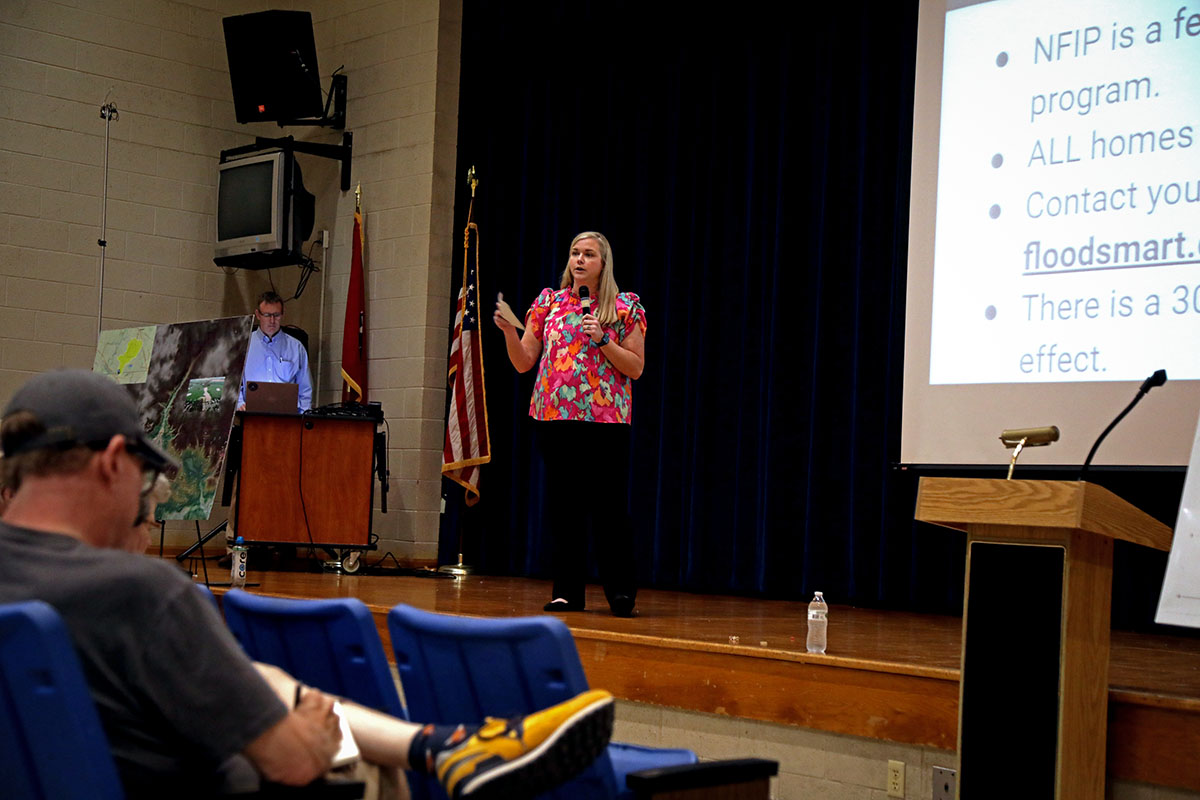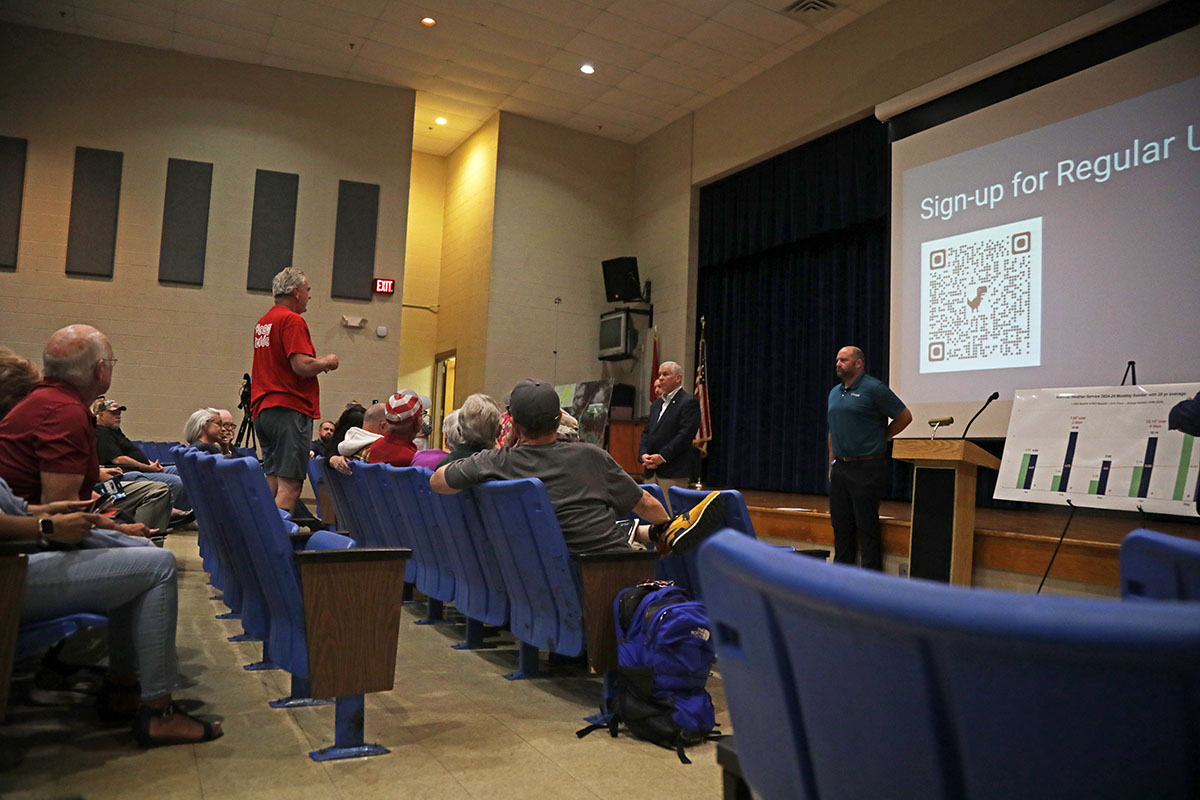CLARKSVILLE, TN (CLARKSVILLE NOW) – Though the flood waters in north Clarksville are receding, tempers have only risen for the residents of Woodstock Estates – tempers that flared during a neighborhood meeting Wednesday night between residents and city officials.
It’s been almost three weeks since the early April storms battered Clarksville, and many questions remained unanswered until the meeting. But along with damaged homes, some of the residents have gotten sick from floodwater contamination, including Sharon Pearson’s husband, who issued a warning to the city: “If my husband dies, it’s going to be a bad day for everyone.”

Mayor vows to ‘make it right’
As the residents trickled into the dimly lit theater at Northeast Middle School, Clarksville Mayor Joe Pitts shook hands, smiled and spoke with many of the arrivals. Once everyone found a seat, he stepped up to the lectern.
“I’ve taken, and rightfully so, my share of criticism for not being more visible during this difficult time for you,” Pitts said. “And while I have been in the neighborhood many times, it has not been enough, and I acknowledge that.
“But this afternoon, we want to make it right,” Pitts told the crowd. “You’re going to leave with some answers, but you’re not going to leave with all the answers because we don’t have those yet. But what you should leave with is a sense of hope and a sense that we’ve got our best people … working on solutions that aren’t just empty promises, but that will get actual results.”
He informed residents that he and other officials would be available for one-on-one questions and personal conversations after the meeting.
| NEWS TIPS: Do you have a local news tip? Email news@clarksvillenow.com or call us at 931-648-7720.
Two potential solutions
David Smith, director of the Clarksville Street Department, explained that this is a “100-year event,” which means there is a 1% chance in every calendar year that a flood of this magnitude is going to happen. Within a month, Clarksville experienced two of these 100-year events.
The flooding is a Kentucky problem that becomes a Clarksville problem when this area gets heavy rain, Smith said. Just over the state line to the northeast, there is a 13-square-mile piece of land that sheds water to a single focal point. In other words, Woodstock and an additional 13 square miles of Kentucky land shed their stormwater runoff to a single sinkhole, located in Kentucky.

Not only that, but Woodstock shares the same elevation as the entire span of land that stretches from the Kentucky sinkhole to Interstate 24, something Smith said is “basically a bowl.” So, what happens when the sinkhole gets full? According to Smith, a river comes in from Kentucky at a rate of 7 million to 7.5 million gallons per hour and fills the bowl.
Currently, the city is considering two options to alleviate this issue. The goal of both is to capture the water (much like a sewer system) through a storm force main and pump it into areas that can handle it. The options considered are the West Fork Red River, or to an existing tributary to Spring Creek.
Flood insurance myths and facts
Lauren Winters, Clarksville grants director, noted that “All homes in the City of Clarksville qualify for National Flood Insurance Program (NFIP),” since Clarksville is a participant in the program. She advised residents to go through the NFIP to get a quote and take it to their insurance agent.

For those who are looking to get out of their homes, Winters explained the requirements of the Tennessee Emergency Management Agency (TEMA) Hazard Mitigation Grant Program (HMGP), specifically, Property Acquisition and Demolition.
In order for residents to have their houses bought and demolished, their houses must have had three years of documented losses (three events in one year counts as one year of loss.)
Additionally, they have to provide an elevation certificate showing the flood map. Unfortunately, the FEMA flood map is outdated and does not reflect the problems at Woodstock. The city is working on getting that revised (taking 1-2 years), but Winters warned residents that if the revised FEMA flood map shows Woodstock is in a flood plain, anyone with a federally backed mortgage will have to get flood insurance, and prior flooding will have be disclosed in any future sales of the home.
Finally, there has to be documentation including pictures and insurance denials. This all comes with a caveat: Water must have reached at least 18 inches above the finished floor of a home, not including the basement/crawlspace. Also, the process takes 36 months from the start of the application to when demolition would occur.
| DON’T MISS A STORY: Sign up for the free daily Clarksville Now email newsletter
Residents refuse to play ‘telephone game’
As the meeting drew to a close, Pitts reminded residents that he and his team would be available at the conclusion of the briefing, but one resident’s voice split through, causing Pitts to say, “We’re not going to take questions from the floor, we’re going to let you come up and we’ll let people answer.”
Shouts of “Why?” broke out across the crowd as another resident yelled, “We want the same clear message!”
“Well, we’ve had the same clear message,” Pitts replied. “What we’re trying to do is you can have individual questions, and we’re going to be up here and answer these questions, even if it’s the same one.”

But the residents dug their heels in, many choosing to stand up and shout their questions from the back of the room.
“We don’t want to have personal conversations!” one woman shouted. “We want to have a neighborhood clear conversation. … It’s getting personal when she hears one thing, he hears one thing, I hear one thing, and that’s unfair to us as a neighborhood. We want to hear it as one clear message and the rumors will stop because we all heard the same thing!”
Though Pitts resisted this method at first, standing by his statement, eventually he and the other speakers relented and began to answer questions as hands were raised, and people called out their concerns.
Residents brought up several issues, including sandbag and water contamination, ongoing nearby construction, why the Woodstock subdivision was even allowed to be built, that the city inherited the problem when Woodstock was annexed, and whether Kentucky has a role to play in fixing the issue.
MORE: ‘There ain’t any money left’: Military couple depletes retirement to recover in Woodstock
MORE: ‘Here we go again’: Homeowners say they were told Woodstock flooding was fixed | PHOTOS


